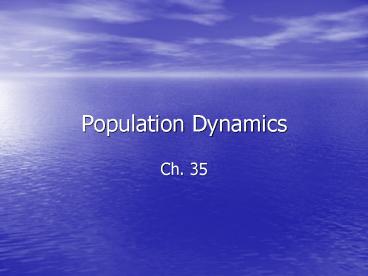Population Dynamics - PowerPoint PPT Presentation
1 / 26
Title:
Population Dynamics
Description:
Population Dynamics Ch. 35 Measuring Populations Population density = # of individuals of a particular species per unit area Measuring Populations, cont. Sampling ... – PowerPoint PPT presentation
Number of Views:358
Avg rating:3.0/5.0
Title: Population Dynamics
1
Population Dynamics
- Ch. 35
2
Measuring Populations
- Population density of individuals of a
particular species per unit area
3
Measuring Populations, cont.
- Sampling used to estimate size of population
- Quadrats count all organisms in a block and use
this to estimate population size - Indirect counting count nests, burrows, etc
instead of organisms - Mark recapture trap animals, mark them,
release, recapture and count marked vs. unmarked
4
(No Transcript)
5
Limiting population growth
- Limiting factor a condition that can limit
population growth - Ex space, food, disease
- Carrying capacity the number of organisms in a
population that the environment can maintain - Birth rate and death rate are about equal
6
(No Transcript)
7
Limiting population growth
- Density-dependent factors a factor that limits
population growth more as the population density
increases - Ex food, disease that spreads by contact
- Density-independent factors a factor that
limits population and is unrelated to population
density - Ex extreme weather
8
Types of population growth
- Exponential population multiplies by a constant
factor at constant time intervals - there are few factors that stop overall growth
- Also known as J-curve
9
Types of population growth
- S-curve population begins growing
exponentially, but environmental factors begin to
limit growth population stops growing or may
begin to decrease
10
Types of population growth
- Boom and bust increase rapidly (boom) and then
decrease rapidly (bust)
11
Population interactions
- Interspecific competition two or more species
rely on the same limited resource - Competitive exclusion when one species succeeds
over the other due to limited resources - Niche each organisms unique living
arrangement, such as habitat, food, time when
active, etc
12
Population interactions
- Predation an interaction in which one organism
eats another - Predator doing the eating
- Prey being eaten
- Both predator and prey have evolved with
adaptations to enhance survival - Ex camouflage, hunting in packs, warning
coloration
13
(No Transcript)
14
(No Transcript)
15
Prey adaptations
16
Population interactions
- Symbiotic relationships a close relationship
between species in which one of the species lives
in or on the other - Parasitism the parasite obtains food at the
expense of the other organism (host) - Mutualism both organisms benefit
- Commensalism one organisms benefits and the
other is neither helped nor harmed
17
(No Transcript)
18
Parasitism blowfly larvae kill purple martin
chick
19
Mutualism sea anemone protects clownfish from
predators clownfish is territorial and protects
anemone from predators and shares food
20
Commensalism grey whale carries barnacles
whale not harmed nor helped, barnacles have more
access to food
21
Disturbances in communities
- Ecological succession community change when new
species colonize disturbed area - Primary succession community arises in lifeless
area without soil - Ex volcano creating new island
- Secondary succession community arises in
disturbed area with soil - Ex growth in plowed farm field
22
(No Transcript)
23
Primary succession growth on lava rock
24
Secondary succession after forest fire
25
Disturbances in communities
- Pioneer species predominant species in the
early stages of succession tend to be small,
fast-growing, and fast-producing - Succession proceeds through many stages until it
reaches a stable end point called the climax
community
26
Pioneer species can grown on rock and will help
form soil































